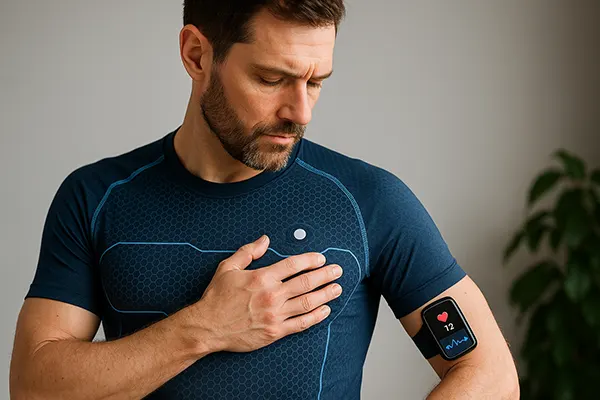
Digital Biosensors in Textiles: Smart Clothing That Detects Illness Before Symptoms
Recent advances in wearable technology have transformed ordinary clothing into intelligent diagnostic tools. Among the most significant developments are digital biosensors embedded in textiles, which can detect physiological anomalies before outward symptoms appear. This early detection capacity has the potential to revolutionise both preventative healthcare and chronic disease management.
The Evolution of Smart Clothing for Health Monitoring
The integration of biosensors into fabrics marks a pivotal shift in how health data is collected. Unlike traditional wearables that rely on external devices like wristbands or patches, smart textiles can monitor the human body in real-time through continuous contact with the skin. These sensors detect temperature, heart rate, respiration, sweat composition, and even biomarkers linked to disease progression.
As of early 2025, companies such as Hexoskin, Myant, and Chronolife have developed clothing capable of recording ECG data, breathing patterns, and activity levels. These garments are especially valuable in clinical trials, remote patient monitoring, and high-performance athletics. With further miniaturisation and improved washability, these products are now transitioning from niche applications to consumer markets.
Furthermore, these smart fabrics are designed with user comfort in mind. The use of conductive fibres woven into stretchable textiles ensures flexibility and durability without compromising sensitivity. As a result, patients can wear biosensor-integrated clothing daily without noticing a difference from regular attire.
How Biosensors Identify Pre-Symptomatic Illness
One of the most promising aspects of textile biosensors is their potential to detect illness in its earliest phases. By tracking subtle changes in vital signs or biochemical markers, these garments can flag anomalies associated with infections, cardiovascular stress, or metabolic shifts—often days before clinical symptoms emerge.
For instance, biosensors can monitor the concentration of cytokines or C-reactive protein (CRP) in sweat, which are known indicators of inflammation or infection. Combined with machine learning algorithms, this data is processed to alert users or healthcare professionals of potential risks, enabling timely intervention.
Studies from the University of California and ETH Zurich confirm that integrating biosensing fibres with artificial intelligence dramatically enhances diagnostic accuracy. The systems can learn to distinguish between routine fluctuations and those warranting medical attention, thereby reducing false positives and improving user trust.
Applications in Chronic Disease and Elderly Care
Digital biosensor textiles hold particular promise for managing chronic diseases such as diabetes, heart failure, and epilepsy. In the case of diabetes, biosensors can measure glucose levels non-invasively through sweat analysis. For cardiac patients, ECG monitoring embedded in shirts allows physicians to detect arrhythmias and intervene before complications occur.
Elderly care facilities increasingly adopt smart garments to support fall detection, respiratory monitoring, and hydration tracking. These metrics are crucial in maintaining the wellbeing of ageing populations and reducing emergency hospital visits. Moreover, caregivers gain remote access to real-time data, enhancing patient safety without compromising independence.
Wearables in eldercare are also reducing operational strain in healthcare systems. Automated alerts generated by biosensors minimise the need for routine physical checkups and enable prioritised care for patients exhibiting warning signs. This strategic shift aligns with global trends toward decentralised and data-driven healthcare models.
Integration with Mobile Health Platforms
Modern smart clothing seamlessly connects with mobile apps and cloud-based health platforms. Users can visualise trends, receive feedback, and share encrypted data with clinicians. These integrations allow for continuous health profiling, facilitating early detection of patterns indicative of disease onset or relapse.
In 2025, platforms like Apple Health, Garmin Connect, and custom dashboards by health tech startups support smart textile integration. These systems use real-time analytics and adaptive algorithms to deliver personalised recommendations, enhancing user engagement and adherence to health plans.
Additionally, smart clothing is becoming compatible with telemedicine services, enabling virtual consultations informed by continuous physiological data. This synergy of textile biosensors and digital health ecosystems is redefining accessibility to quality care, especially in remote or underserved areas.

Technical Challenges and Future Prospects
Despite impressive progress, challenges remain in terms of mass production, affordability, and regulatory approval. Textile biosensors must endure washing cycles, environmental stress, and long-term wear without performance degradation. Manufacturers are currently investing in nanomaterial coatings and advanced encapsulation techniques to improve durability and reliability.
Another hurdle is data security and standardisation. As biosensor garments transmit sensitive health data, developers must implement robust encryption and comply with data privacy regulations such as GDPR and HIPAA. Interoperability between different sensor types and platforms also requires unified frameworks and cross-industry cooperation.
Looking forward, researchers are exploring biosensors capable of monitoring hormone levels, genetic material, or even pathogens like viruses and bacteria. These next-generation sensors may offer pre-symptomatic detection of a broader range of diseases, from hormonal imbalances to emerging infectious threats, fundamentally altering public health strategies.
The Role of AI in Smart Textile Innovation
Artificial intelligence is critical in transforming biosensor data into actionable insights. AI models analyse continuous streams of biometric input, identifying correlations that may be imperceptible to human observers. This allows for dynamic health assessments tailored to individual baselines rather than rigid clinical norms.
Companies like Sensoria and Xenoma are embedding edge AI chips directly into clothing, reducing latency and ensuring privacy by processing data locally. These systems can detect early signs of atrial fibrillation, respiratory distress, or glucose irregularities with unprecedented accuracy.
Moreover, the integration of AI enhances predictive capabilities. Rather than simply alerting to current abnormalities, smart textiles are evolving to anticipate health trends. This shift from reactive to proactive care could significantly reduce the burden of chronic illnesses and hospitalisation rates globally.
